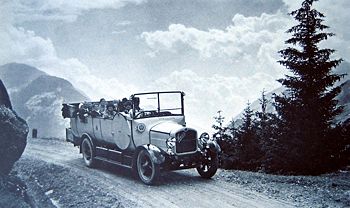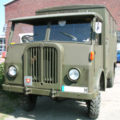- Saurer
-
Adolph Saurer AG was a Arbon, Switzerland (Swiss), based manufacturer of trucks and buses, under the Saurer and Berna (beginning in 1929) brand names, and active between 1903 and 1982.
Saurer was very well known all around Europe in the years between World War I and World War II (1918-1939).
Contents
History
 A Saurer Car-Alpin in 1930
A Saurer Car-Alpin in 1930
Saurer ran subsidiary companies in Austria (1906-1959, in the end taken over by Steyr-Daimler-Puch), France (1910-1956, taken over by Unic), the United Kingdom (1927-1931, taken over by Armstrong Whitworth), and in Germany (1915-1918, taken over by MAN).
In Italy, Officine Meccaniche (OM) was for many years licensee of Saurer engines and other mechanical units, which they used in their own ranges of truck and buses
In the United States, the Saurer Motor Truck Company, headed by C.P. Coleman, had the rights to manufacture and sell heavy trucks under the Saurer brand name at its plant in Plainfield, New Jersey (which commenced operations in November 1911). On September 23, 1911, the Saurer Motor Truck Company merged with the Mack Brothers Motor Car Company of Allentown, Pennsylvania, headed by J. M. Mack, to form the International Motor Truck Company (IMTC)[1]. IMTC would continue to make and sell trucks using the Saurer name until 1918. In 1922 IMTC would become Mack Trucks, Inc.
Saurer trucks were developed along the years into four basic ranges:
- A-type (1918)
- B-type (1926)
- C-type (1934)
- D-type (1959)
It was the B-type that established Saurer's international reputation as builder of long-lasting trucks.
In 1929 Saurer acquired its Swiss rival, Motorwagenfabrik Berna AG of Olten, but the Berna name was allowed to continue, badging the very same Saurer models.
From 1932 on, trolleybuses were a very significant segment of Saurer production. Typically Saurer, or Berna, trolleybuses featured Brown, Boveri & Cie or Société Anonyme des Ateliers de Sécheron (SAAS) electric equipments and Carrosserie Hess bodies. Saurer trolleybuses operated in most of Central Europe countries, and still do it in several of them.
At the World War 2 a restructured type BT 4500 and 5 BHw of Saurer trucks was used to gas people in Nazi extermination camp Chelmno [2].
In 1951 Saurer and its Italian licensee, OM, reached an agreement by which Saurer would market in Switzerland OM's light and medium-weight trucks and buses, using Saurer-OM and Berna-OM badges. This was successful and lasted until Saurer closure.
NAW
Declining sales in the early 1980s saw the two leading Swiss truck makers, Saurer and FBW (Franz Brozincevic & Cie of Wetzikon, Switzerland), forming a joint organization called Nutzfahrzeuggesellschaft Arbon & Wetzikon, proceeding with motorbuses and trolleybuses production under the NAW brand, while the last Saurer-badged truck sold in the open market was delivered in 1983. Four years later, in 1987, a model 10DM supplied to the Swiss Army meant the very last Saurer truck produced in history.
In 1982 Daimler-Benz had acquired a major shareholding in NAW and soon took full control; and in a short time dropped Saurer, Berna and FBW brands, while using NAW premises to assemble heavy haulage versions of Mercedes-Benz trucks.
Eventually NAW went into liquidation in early 2003.
The textile and automotive spin-offs
In 1995, Ernst Thomke, reputed Swiss Manager, took over the leadership of Saurer AG in Arbon as Chairman of the Board. To restructure this conglomerate, he had previously abandoned his position with its then major shareholder: BB Industrie Holding AG (22%). The previous major shareholder, Tito Tettamanti, of the conglomerate, founded in 1853, specialized in textile machinery and "propulsion technology", had acquired the main competitor in each field, Schlafhorst, with a large manufacturing capacity excess and Ghidela .
Thomke led actively Saurer AG until 1996, when he retired to the direction of the Board until 1999. In his years he promulgated transparency at all levels, flexible working hours, optimized the production and refined accounting systems. In 1996, the group Saurer AG went back into financial results showing profits. More than half of the revenues originating from Schlafhorst, upon its positive restructuring.
Oerlikon Textile
Since 2007, the conglomerate Saurer AG, which meanwhile had reached a worldwide leading status in textile machinery, has been integrated into the Oerlikon Corporation (see: [1] Oerlikon Textile )
Oerlikon-Saurer Textile is the world’s leading manufacturer of technologically sophisticated systems for spinning, texturizing, twisting and embroidery. Saurer Textile brings together eight brand names: Allma, Barmag, Melco, Neumag, Saurer Embroidery, Schlafhorst, Volkmann and Zinser. The products and services of each of these companies play a key role in the value creation process within the textile industry. A high level of technological competence in the field of textile machinery is combined with a consistent client orientation providing solutions which offer Saurer customers throughout the world significant advantages in their tough competitive environments.
Oerlikon-Saurer "Graziano Trasmissioni
Also since 2007, the remaining Saurer AG automative part, "Graziano Trasmissioni", a leading manufacturer for sophisticated gear, gear groups and complete transmission systems for agricultural, earth moving and special vehicles as well as for four wheel drive passenger cars and luxury sport cars has also been integrated into the Oerlikon Corporation. (see: [2] Oerlikon Drive Systems)
Gallery of Saurer, Berna and NAW vehicles
-
Saurer PostBus, c.1950
-
A Saurer trolleybus in Timişoara, 2005
-
Saurer 4TIILM trolleybus in Gdynia, 2006
-
Carrosserie Hess bodied NAW trolleybus in Schaffhausen
See also
Sources & References
- ^ "Motor Truck Merger". - New York Times. - September 23, 1911. - p.15. - Retrieved: 2008-06-16
- ^ "Nazi Gas Vans" - http://strangevehicles.greyfalcon.us/NAZI%20GAS%20VANS.htm
- [3] Oerlikon Google Finances
- [4] Oerlikon Milestones / January 2007 : incorporation of Saurer AG
- [5] *Federal Registry of Commerce Switzerland Canton of Schwyz, Switzerland
External links
Categories:- Companies established in 1902
- Companies disestablished in 1982
- Defence companies of Switzerland
- Defunct bus manufacturers
- Defunct companies of Switzerland
- Swiss brands
- Trolleybus manufacturers
- Truck manufacturers
- Motor vehicle manufacturers of Switzerland
Wikimedia Foundation. 2010.











